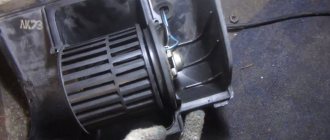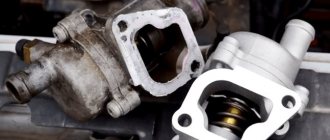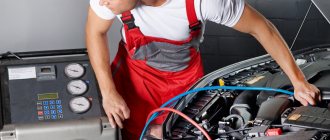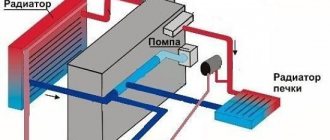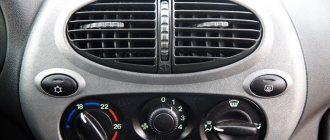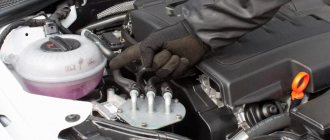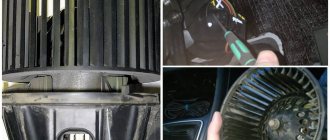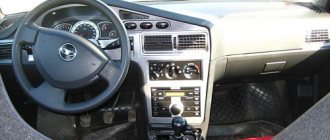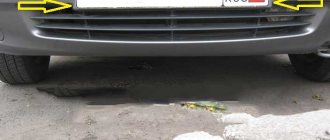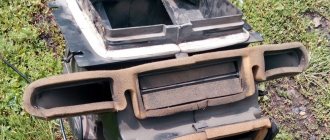In winter cold, the car's heating system must work like a clock. A breakdown of the stove can in some cases lead to loss of health or even life if it happens somewhere on the highway, far from populated areas.
This article will tell you how the heating system installed on a VAZ-2115 car works, as well as how to repair it.
The design and principle of operation of the VAZ 2114/15 stove
The heating system of the VAZ 2114/15 is designed to heat the air entering the passenger compartment. Its design is the same in cars with injection and carburetor engines. The coolant heated by the engine flows from the cooling system into the heater radiator, which is blown by a fan. The flow of warm air created in this way enters the cabin through the air duct system. The intensity and direction of air flow is regulated using deflectors and dampers. The interior heating system of the VAZ 2114/15 can operate in several modes.
The VAZ 2114/15 stove is designed quite simply: 1 - assembled heater; 2 — protective casing; 3 - seal; 4 — front air duct; 5 — rear air duct; 6 — rear air duct; 7 — right nozzle; 8 — right side air duct; 9 — right side nozzle; 10 — intermediate body; 11 — central nozzle; 12 — draft of the windshield heating flap; 13 — heater control levers; 14 — control handle for the heated windshield damper; 15 — heater control handle; 16 — symbol plate; 17 — control handle for the foot heating damper; 18 — right air duct; 19 — interior heating air duct; 20 — heater control damper rod; 21 — heater valve control rod; 22 — heater valve; 23 - leg heating damper rod
Interior heating. The stove doesn't heat
Due to a leak, I replaced the interior heating radiator. I changed it without disassembling the dashboard, but simply by unscrewing it and moving it forward and upward. Raft radiator. So, after all this torment of replacement, the stove stopped heating, not just completely, but definitely 4 times worse... I was driving from Ekb to my native Satka, the stove was at maximum, and on the windshield and side windows... ICE! Wow, Samaras are distinguished by their “ardor”... But here it’s just ice that doesn’t melt =( I changed the thermostat, the situation improved a little, but the problem remained...
Who has experience with such situations? Tell! It's winter outside! I can also say that there is most likely air in the system, since sometimes you can hear gurgling in the area of the heater core... I tried to get it out by removing the throttle heating pipe, it seems like some air came out, but sometimes there is still gurgling. Does anyone know how to properly and efficiently remove air from the system? In general, I would be glad to hear any recommendations on this matter...
In general, I tried all the options. I expelled the air, checked the dampers, cables, etc. Yes, after you expelled the air (through the throttle heating) it became HOT! But, only while you stand for about 40 minutes... That is, air is sucking in somewhere. The pipes are sealed - checked. I began to thoroughly study the system and discovered: on a cold car at a speed just above 1500, bubbles come out of the outlet pipe of the tank, an abnormal amount of condensate comes out of the silencer, thick, white smoke (though not much). No matter how sad it may sound, it’s her... The cylinder head gasket... Damn her... But at least I figured out what was going on. Now it's a small matter - all that remains is to fix it)))
12/27/2011. I replaced the cylinder head gasket... I changed it myself, since there is no money for a service station before the new year =) I killed the whole day... Aaaand... the problems are gone: the antifreeze is in place, the car is warm, it no longer gurgles anywhere. I'm happy =) - and that's the main thing! I advise everyone who is replacing a heater radiator - do not buy any other than the original DAAZ ones. Everything except DAAZ simply doesn’t heat up - it’s been proven!
Stove design
The VAZ 2114/15 stove consists of the following elements:
- Fan.
- Windshield defroster.
- A distribution flap that directs air flow to the central and side deflectors, to the lower and upper parts of the cabin.
- Control valve.
- Stove radiator.
- Duct that directs air flow to the legs.
- Internal air duct.
The stove consists of a fan, dampers, radiator and air ducts. Blue and red colors indicate the flow of cold and hot air, respectively.
Symptoms of a problem
Many car owners who operate VAZ family cars complain about the build quality of the heating systems of domestic cars. Often, a completely new vehicle turns out to be simply crammed with a lot of flaws and defects.
Among the frequently encountered ones are the following: when the stove is operating, hot air is supplied exclusively through the central openings, while a slightly warm breeze blows from the side deflectors - both upper and lower. As a rule, this indicates that the air ducts were poorly assembled on the conveyor. As a result, large gaps remained between them and the dampers. In this case, you will have to adjust the rods. In this case, most likely, you will need to disassemble the instrument panel to gain access to them.
Problems with the dampers, in turn, lead to the fact that you have to wait a long time for the windshield to thaw.
The list of other possible failures and the reasons that led to them is as follows:
- at idle almost cold air comes in - the pump is faulty or the heater radiator is clogged;
- cold pipes (including those blowing into the feet) - the thermostat is jammed, the heating tap does not open;
- side deflectors supply unheated air - problems with dampers and rods.
Experienced auto mechanics recommend installing a similar suitable unit from a foreign car instead of the “native” fan. This usually significantly improves heating efficiency.
As a preventative measure, you should also ensure that antifreeze is filled in the required quantity at all times. Don’t forget about the need to regularly ventilate the radiator.
Heater fuse and reasons for its failure
Often the cause of malfunction of most components and systems of a car is a blown fuse. The stove is no exception. Failure of a 30A heating system fuse causes the fan motor to stop and air to stop flowing into the cabin. In this case, find an element marked F7 in the fuse block and replace it. The new fuse should also be rated 30A. If the fan does not work after this, the problem should be looked for elsewhere.
Heater fuse F7 is located in the mounting block under the hood on the driver's side
It is often difficult to determine that it is the fuse that has blown. It can fail due to a short circuit in the electrical wiring, a malfunction of the electric motor, severe clogging of the cabin filter and in a number of other situations. The difficulty lies in the fact that fuse F7 is simultaneously included in the rear window heating electrical circuit and is responsible for the cigarette lighter, glove compartment lighting and headlight washer motor. If it fails, all these components will not work.
Connection diagram for the VAZ heating system
- Mounting block.
- Ignition.
- Unloading ignition relay.
- Heater motor switch.
- Additional resistor.
- Stove motor.
- Stove control button.
- Heated rear window.
K7 is a relay that turns on the heated rear window.
Why the stove does not work or does not heat the air
If the stove fails, it either does not work at all, or it works but does not heat the air. In the first case, first check the fan wiring, starting with fuse F7. If the fuse is blown, replace it. Then they check the relay, which may not turn on the first time or only when the engine is warm. In this case, the relay is replaced with a new one.
Then the serviceability of the electric motor is assessed. To do this, power is directly supplied to its contacts from the battery. If the electric motor starts to operate at maximum speed, then it is in good condition. Otherwise, it will need to be repaired or replaced.
The intensity of the air flow is adjusted using a resistor having two spirals with resistances of 0.82 Ohm and 0.23 Ohm. In the first mode, the current flows through both spirals, in the second - only through a spiral with a resistance of 0.23 Ohms, in the third - bypassing the spirals, that is, without resistance at all. If the resistor is faulty, the fan will only operate in the third mode at maximum speed (handle in the extreme right position). The problem is solved by replacing the resistor, which is located on the driver's side above the accelerator pedal.
If the resistor is faulty, the heater fan will only be able to operate at maximum speed.
If cold air enters the cabin, this may be due to:
- Airlock. It could have formed when replacing the coolant, when the system was depressurized, or because there was insufficient amount of coolant in the system. To remove the plug, remove the heater radiator pipe, use a watering can to add antifreeze to the maximum and put the hose back in place. After starting the engine, coolant under pressure will displace the remaining air from the system.
- Stove tap jammed. This happens if the tap was not initially opened all the way, and during operation, oxide and scale formed on the inner surface, preventing the normal circulation of the liquid. You can try to open the tap using pliers or immediately replace it with a new one.
- The stove radiator is clogged. When using low-quality coolant, the radiator honeycombs may become clogged. The problem is solved by flushing or replacing the heat exchanger. The feasibility of washing is determined by the scale of contamination.
- Installation of a low-quality radiator. In a defective product, the honeycomb may be incorrectly soldered. The radiator should be replaced.
- Low pressure in the cooling system. If heat transfer increases at higher speeds, the pump needs to be replaced.
- Low coolant level. It is necessary to check the level and add antifreeze if necessary.
- Damage to the heater fan impeller. The impeller is carefully inspected and replaced if mechanical damage is detected.
- Cabin filter dirty. If it is heavily polluted, the power of the electric motor will not be enough to pump warm air into the cabin. The filter is replaced with a new one.
- Damage to the cylinder head gasket. If the cylinder head gasket is blown, white smoke will come out of the exhaust pipe. The problem is solved by replacing the gasket and dismantling the cylinder head.
If the stove is clogged, warm air will stop flowing into the cabin.
Diagnosis of stove malfunctions
The design of the stove is quite simple. It would seem that there is nothing to break here. The heater cannot break down completely, since its design consists of components independent from each other. However, some elements can fail quite often. These include:
- radiator;
- tap;
- pipes;
- resistor;
- mode switch.
Heater radiator malfunctions
The main reasons for the failure of the stove radiator:
- clogging;
- the appearance of a leak (depressurization).
In the first case, deposits accumulate on the inner walls of the radiator tubes. They can form as a result of:
- long-term operation of the radiator;
- use of low-quality coolant;
- getting dirt, friction products, water, etc. into the cooling system.
As a result, the circulation of antifreeze in the heater radiator is disrupted or completely stopped, and the air entering the cabin does not have time to heat up normally. In winter, it will be cold inside the car, and defrosting the windshield will become a real problem.
A leak in the radiator can appear as a result of corrosion and drying out. Coolant leaking from the heater usually forms a puddle on the floor under the panel on the passenger side. In addition, a characteristic odor will appear in the cabin, and an oily coating will form on the windshield due to evaporation of the coolant, reducing the driver’s visibility. The latter is especially true when driving against the sun or at night, when oncoming traffic is moving with its headlights on.
Stove tap leaking
The stove valve may fail for two reasons:
- souring of the locking mechanism;
- drying out of the device casing.
If the stove has not been used for a long time, the tap may become sour. In this case, when trying to open the tap, you should not use much force, as you can damage the tap itself or break the control cable.
When the housing dries out, the leak may not be immediately noticeable. But after some time, signs similar to those of a radiator leak will appear (a puddle of coolant on the floor, a pungent odor in the cabin, an oily coating on the windshield).
If the heater valve is faulty, coolant begins to leak into the cabin.
Wear of pipes
Antifreeze from the heater radiator may begin to leak through the inlet and outlet pipes as a result of their wear under the influence of chemically active substances included in the coolant and high temperature. In addition, the pipes can be damaged if the clamps that ensure the tightness of the connections are over-tightened.
There are a total of four pipes in the heating system of the VAZ 2113–15 - two in the engine compartment, connecting the engine to the tap, and two in the cabin, going from the tap to the heater radiator. Coolant leakage can occur in different ways. In one case, the antifreeze will flow onto the engine protection and onto the street, in the other - into the car interior. In any case, it will appear as:
- drop in coolant level in the expansion tank;
- puddles forming under the car or in the cabin;
- the appearance of an unpleasant odor in the cabin.
If the heater pipes are damaged, coolant may begin to leak into the passenger compartment.
Resistor failure
The stove resistor consists of two windings and serves to change the resistance of the electric current supplied to the fan. The fan motor can operate in three modes, which can be changed using a switch.
In the third mode, the fan is supplied with a voltage equal to the voltage of the on-board network, and it operates at full power. When the second mode is turned on, the voltage decreases due to one of the windings, the resistance of which increases to approximately 0.2 Ohms. The fan begins to rotate noticeably slower. And finally, in the first mode, the resistance of the windings increases to 0.8 Ohms, and the power of the electric motor is reduced to a minimum.
The main sign of resistor failure is the fan operating only in the third mode. The reason for this is the burnout of one or both windings.
If the resistor fails, the stove operates in only one mode
Switch failure
The cause of a non-working interior heater can only be determined after checking each of its elements. Sometimes the stove mode switch itself may fail. This occurs quite rarely as a result of oxidation or destruction of its contacts.
Use the switch to change the fan speed
Heater dampers don't work
The distribution of air flows throughout the cabin is carried out by dampers, which, in turn, are controlled using cables. When these cables fail, problems arise with directing the air flow to the windshield or to the foot area. In addition, the damper that blocks the flow of air from the street begins to work incorrectly. In this case, adjustment of the damper drives is required.
Such situations can arise even on a new car. Slightly warm air begins to flow from the lower, upper and side deflectors, and hot air begins to flow from the center console. This is due to the poor build quality. There are gaps between the joints of the air ducts and the dampers, which leads to warm air entering only from the center console and heating the panel from the inside.
The drive cable is always taut. Therefore, over time it bends, breaks off or stretches. In this case, it is necessary to adjust the damper drive, which is performed in the following order:
- In the stove, we look for a bracket with which the cable sheath is held on the heater body.
- A galvanized metal lever located on the left side is pulled back. This position corresponds to the maximum opening of the damper.
- The length of the cable is tightened and adjusted. The long lever on the lever block in the extreme right position should open the damper completely.
- After adjustment, the cable is securely fixed.
Video: stove repair using the example of a VAZ 2114
Heater device
The stove installed on the VAZ-2115 injector is exactly the same as on the earlier “nine”.
The main elements of the heating system are as follows:
- fan;
- radiator;
- air ducts;
- damper rods;
- heater valve;
- resistor;
- motor;
- thermostat.
Coolant, heated from a running 8-valve engine, enters directly into the radiator. The fan blows on the metal plates of the heat exchanger and the air heated in this way enters directly into the interior of the car.
Immediately after the heating circuit is turned on, the heating valve opens and supplies antifreeze to the radiator.
The rods regulate the air supply and the direction of its jets. With their help, you can provide heating to the windshield or direct hot air to frozen feet. By including a resistor in the circuit, it is possible to create a certain resistance, which allows you to regulate the operation of the heater. The thermostat ensures the movement of coolant through two circuits (small and large).
If the last device jams, then the movement of antifreeze occurs only through one of them, which increases the risk of overheating of the power plant. The heating of the car interior is organized through a large cooling circuit. That is, if the thermostat gets stuck on low, heating will not occur.
Often there are also problems with the fan motor. In this case, warm air will not be able to pass through the air ducts and deflectors in the cabin.
As you might guess, in general, the heating system is quite simple, and has previously been used in many other cars. New cars usually do not have any problems of this kind, but over time, as they are used, the chances of a breakdown increase significantly.
Replacing and connecting the stove
Installing a new heater radiator is done in the reverse order. When installing rubber hoses, it is recommended to treat them with sealant. When connecting electrical connectors, use the markings applied during disassembly.
After assembly, coolant is poured into the system. To prevent an air lock from forming, remove the hose from the throttle assembly after loosening the clamp. Antifreeze should be poured into the expansion tank slowly, observing the disconnected hose. As soon as coolant flows out of it, the hose should be put back on the fitting and tighten the clamp. If everything is done correctly, the operation of the stove will not cause any complaints.
When installing a new heater radiator, it is recommended to pre-treat the pipes with sealant
Video: dismantling the VAZ 2114 stove
Fan motor repair
If the electric motor malfunctions, it should first be removed and then the feasibility of repair should be determined. It is necessary to evaluate the condition of the brushes, armatures, windings, and check the integrity of the wire insulation. The contact area of the brushes on the armature can be cleaned with zero grade sandpaper. You should also pay attention to the bushings and bearings - clean the rubbing parts from dirt and apply lubricant (for example, Litol). All elements with signs of wear must be replaced.
When installing a new heater radiator, it is recommended to pre-treat the pipes with sealant
Heater radiator repair
Usually, if mechanical damage is detected, the stove radiator is replaced with a new one. However, some car owners try to repair cracks and holes using soldering. A copper radiator is quite easy to solder, and it is much easier to restore than an aluminum one. To repair an aluminum heat exchanger, you will need special flux and tinning solder, as well as a powerful soldering iron. The damaged area is first cleaned of dirt and degreased. Then flux and solder are applied to it with a soldering iron. After soldering, it is recommended to check the radiator under pressure to make sure there are no leaks.
Cleaning and flushing the radiator of the VAZ 2114/15 stove
You can increase the efficiency of the stove by cleaning and flushing the radiator. The procedure can be performed without dismantling the radiator or with dismantling it. In the first case, you will need to remove the outlet and inlet pipes from the heater and pour a cleaning solution into it. Citric acid, plumbing cleaners (for example, “Mole”), etc. are used as such a solution. Then the radiator is washed with running water and coolant is added. You can clean the radiator better by removing it from the car. This will allow you to wash it not only from the inside, but also from the outside, removing dirt between the honeycombs. Washing is usually carried out with running water.
If after performing these procedures the stove does not work better, the radiator must be replaced.

